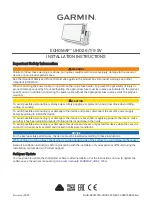
Differential and RTK Operations
59
Differential and RTK
0.5cm+1ppm (1
σ
horizontal), and is independent of the rate at which the receiver
receives type 18 and 19 messages.
Fast RTK
In this mode the remote receiver’s update rate is selectable up to 5Hz, and is
independent of the rate at which it receives type 18 and 19 messages. Use the
command $PASHS,NME,PER to control the update rate. The latency of position is
less than 100 ms. The precise latency (to 1ms resolution) is available in the LTN
message. Typical accuracy (1
σ
horizontal) in centimeters is equal to the base-remote
data latency in seconds, for data latency of up to 10 seconds. For base-remote data
latency of greater than 10 seconds and less than 30 seconds, the accuracy degrades up
to 2 meters. In Fast RTK mode the receiver will always provide the best possible
position solution at the data rate selected by the user. If the accuracy degrades for any
reason (such as cycle slips, lost radio link, etc.), this will be reflected in the GST
message. By contrast, the Synchronized RTK position only provides positions when a
fresh set of base station data has been received.
Fast RTK should be used when you need position updates at regular intervals, (such
as in machine control). Synchronized RTK should be used when you can afford to
wait a few epochs for the highest available accuracy (such as in surveying).
During Fast RTK mode the receiver runs synchronized RTK mode in the background
at the same rate that it receives base station data. If the receiver detects a cycle slip, it
fixes the cycle slip at the next synchronized epoch (typically within one second).
If you are using Fast RTK mode you should monitor position accuracy using the GST
message.
Example: Fast RTK running at 5Hz. Type 18&19 message updates at 1Hz.
Cycle slip occurs at time 12:00:00.1 (100 milliseconds past noon). There
will be 4 epochs of Fast RTK positions with an error of a few decimeters,
each will have a corresponding GST message showing that there is an error.
Then, at 12:00:01.0 (1 second past noon) the cycle slip will be repaired.
Position Latency
Base data latency, discussed above, is the delay between when a base station
measures the GPS&GLONASS signals and when the remote receiver receives the
RTCM messages. Position latency is the delay between when the remote receiver
measures the GPS&GLONASS signals and when the position is available at the serial
port. In other words, position latency is the delay in providing the user’s actual
position to the user. Position latency is typically between 50 and 100 milliseconds, it
varies with the number of satellites in view. The actual position latency, to one
millisecond precision, is provided by the LTN message for each epoch.
Summary of Contents for GG Surveyor
Page 14: ...xiv GG Surveyor GPS GLONASS Reference Manual...
Page 38: ...20 GG Surveyor GPS GLONASS Reference Manual...
Page 62: ...44 GG Surveyor GPS GLONASS Reference Manual...
Page 86: ...68 GG Surveyor GPS GLONASS Reference Manual...
Page 232: ...B 6 GG Surveyor GPS GLONASS Reference Manual...
Page 236: ...C 4 GG Surveyor GPS GLONASS Reference Manual...
Page 246: ...E 6 GG Surveyor GPS GLONASS Reference Manual...















































